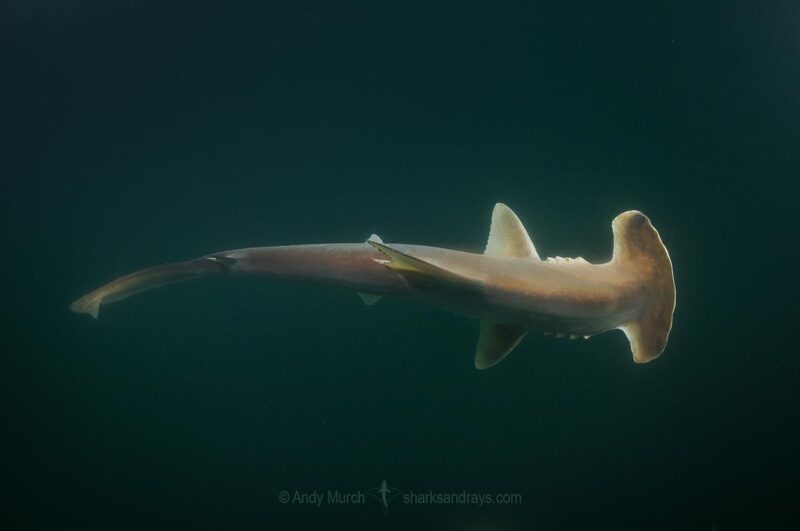Scoophead Shark, Sphyrna media, a small species of hammerhead shark confined to the coastal waters of Central America. Released Specimen. Isla Chepillo, Rio Bayano, Panama.
Andy Murch
It was early morning, the sky still painted in soft grays, and the sea was calm, almost glassy. Dr. Diego Cardeñosa of Florida International University was on a small fishing boat and the air was filled with the smell of salt and diesel, the hum of the outboard engine, and the quiet anticipation that comes from long hours spent watching the water. Just another day trying to understand the lives of small coastal sharks.
Then it appeared.
At first, he thought it was your run-of-the-mill hammerhead, but something about the shape of its head stopped him cold. He froze, his heart skipping a beat. He already knew. “It’s humbling and emotional [to discover a species that few scientists have ever seen in the wild]. The first time I held a scoophead, I knew I was looking at something most people in the world — including scientists — never get the chance to see. It makes the conservation urgency very real, because you realize how close we are to losing it,” Cardeñosa explained in an e-mail.
The scoophead shark, Sphyrna media, is barely known even among shark scientists. Its distribution is limited, it is naturally rare, and decades of coastal fishing have pushed it further to the margins. Only a handful of confirmed sightings exist. So when Cardeñosa and his team finally saw one in the wild, it was the kind of encounter that changes everything: “They remind us that many species are slipping away without notice. Each rare encounter is a wake-up call to act before it’s too late, not just for the species we find, but for the ecosystems that sustain them.” The importance of their work became real in a visceral way. Every effort to document and understand this shark matters because if they lose it, they also lose the story of its ecosystem, a chain reaction of impacts we can’t easily reverse.
But what makes this encounter even more remarkable is the partnership behind it.
Four years ago, Cardeñosa and his team began working with five coastal fishing communities in the Colombian Pacific. Initially, fishers were simply part of the problem. Sharks were caught, consumed, or sold with little thought for the species’ long-term survival. Today, these same fishers head out weekly to collect scientific data with Cardeñosa. They measure, tag, sample, and release animals, and last year alone they tagged over 200 small hammerheads. “The shift has been remarkable: not only are they helping us build science in real time, but they also now release every shark they catch during their daily fishing because they want to keep the project going and they realized how unique and threatened these species are,” he said. “They now realize we might be looking at the only viable population of scalloped bonnetheads and Pacific smalltail sharks left.”
What started as outreach has evolved into genuine co-ownership of science and conservation. After all, fishers are the eyes and ears of the ocean! They know where species appear, when they vanish, and the subtle shifts in their ecosystem. Collaborating with them transforms conservation from a top-down mandate into a bottom-up movement. (This means that instead of conservation being imposed by governments or external organizations, local communities and fishers take an active role in protecting species, making decisions and actions that come from their own knowledge and experience rather than just following rules. It shifts the power and responsibility to the people who live and work directly in the ecosystem.) And training, sharing data, and co-developing solutions turns fishers into allies, not just participants. The results so far have been very tangible: more data collected in real time, better protection for sharks, and a shift in community culture toward stewardship. While environmental DNA, acoustic telemetry, and bycatch reduction devices provide data, it is ultimately the fishers who understand how fishing actually happens on the water. “When you merge the two, you get practical, effective solutions.”
Scoophead Shark, Sphyrna media, a small species of hammerhead shark confined to the coastal waters of Central America. Released Specimen. Isla Chepillo, Rio Bayano, Panama.
Andy Murch
The next step in this partnership? Testing bycatch reduction devices. These gear modifications allow sharks to escape while still letting fishers catch target species. “It means fishers don’t lose income, but sharks get a chance to survive. It’s a win-win that builds trust and keeps communities on board,” said Cardeñosa. They will soon start testing these devices with the longline fishers in these communities.
The single scoophead shark observation has certainly had a ripple effect here. It has proved that the species still exists in that habitat, which justifies conservation funding, habitat protections, and careful fisheries management. But protecting the spaces scoopheads occupy benefits not just them but an entire suite of species sharing the same ecosystem. Rare encounters can catalyze protection strategies that safeguard biodiversity at multiple levels, from top predators to the smallest reef dwellers. And this conservation model is scalable. While the specifics will vary by region, the principle is universal: build trust, value local knowledge, and co-create conservation tools. Whether it’s the Colombian Pacific or coral reefs in the Indo-Pacific, the framework remains the same. Communities everywhere can move from harvesting sharks to helping conserve them.
With the shark in hand, every tag, measurement, and sample Cardeñosa’s team took mattered. Every detail counted toward understanding a species that could vanish without anyone noticing. And when they wrapped up and let the predator go, it disappeared into the azure waters with a powerful flick of its tail. The team watched the ripples fade and, for a moment, the world felt impossibly vast and fragile at the same time. Encounters like this linger, changing how you carry the ocean with you long after you leave it…









